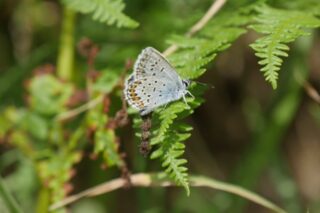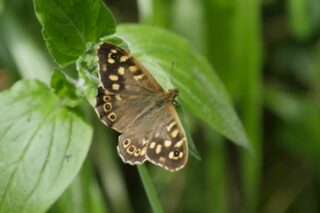 July is a fantastic month for spotting butterflies in the garden and out and about on a walk. Particular species of interest on the wing this month are the silver-studded blue and purple hairstreak. The silver-studded blue is uncommon on our land but has been recorded at Nare Head and on the Dodman. Strong holds for this species occur at Gwithian and other dunes along the north coast where 1000s can be spotted. The purple hairstreak is a lovely woodland butterfly. More difficult to spot and often overlooked as it spends most of the day in the tree canopy feeding off aphid sap or honey dew. We know these are at Messack Woodland and Paradoe Valley on Nare Head. A tip for spotting them is to look in the evening when they tend to come down the woodland floor to roost.
July is a fantastic month for spotting butterflies in the garden and out and about on a walk. Particular species of interest on the wing this month are the silver-studded blue and purple hairstreak. The silver-studded blue is uncommon on our land but has been recorded at Nare Head and on the Dodman. Strong holds for this species occur at Gwithian and other dunes along the north coast where 1000s can be spotted. The purple hairstreak is a lovely woodland butterfly. More difficult to spot and often overlooked as it spends most of the day in the tree canopy feeding off aphid sap or honey dew. We know these are at Messack Woodland and Paradoe Valley on Nare Head. A tip for spotting them is to look in the evening when they tend to come down the woodland floor to roost.
Alongside these less common species there are lots of others you should be seeing in July. The ‘whites’, which includes large, small and green veined whites, meadow browns and ringlets common in grassland areas. Speckled woods love hedge rows and woodlands as the name suggests and the gatekeeper, also a hedgerow lover.
Across the Roseland we have five butterfly transects walked by volunteers every week from April to October. This data feeds back to national database and forms part
of the biggest citizen science projects in the world. The data is invaluable for modelling what is happening to our wildlife as butterflies are key indicator if habitat health. Where we monitor butterflies on our land also helps to tell us how our management is working or not working to improve biodiversity.
Another way to get involved with butterfly monitoring is to join in with Butterfly Conservations Big Butterfly Count. Butterfly Conservation are the leading charity in the UK helping to reverse the decline in butterfly numbers and species in the UK and abroad.
The Big Butterfly Count will be held between the 15th July and the 7th August. Download the app or print of a recording form and sit in your garden, park and favourite spot outside and see how many butterflies of each different common species listed you see in 15 minutes. You can then look at an interactive map and see how your data is contributing to conservation science and research.
Happy hunting!
Harriet Davies, Lead Ranger Roseland<
roseland@nationaltrust.org.uk

